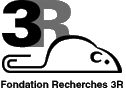
Maja Ponec and A. Weerheim
Skin Research Laboratory, Department of Dermatology, Sylvius Laboratories, Leiden University Medical Center, 2333 AL Leiden, The Netherlands
m.h.ponec-waelsch@lumc.nl
Keywords: skin; barrier systems in vitro; irritation: eye and skin; cell cultures: reconstituted tissue; reduction; replacement
Duration: 2 years Project Completion: 2001
Background and Aim
Reconstructed human skin equivalents are the model that most closely mimics normal human skin. They allow the topical application and skin irritancy testing of a great variety of products used in daily life. One of the major requirements for skin irritancy screening is the presence of a competent skin barrier. In native skin this barrier function is carried out by the uppermost layer of the skin, the stratum corneum (SC). In studies with skin equivalent cultures, it has become evident that this barrier function is impaired. In order to further improve this in vitro model, detailed information on lipid processing within the SC is required. The aim of the project is to define the changes that occur in lipids from the surface of the SC to the deeper layers. Based on this information, it might be possible to modify the culture conditions for the reconstructed epidermis in order to optimise the barrier function.
Method and Results
Up until now, lipid analysis of the SC has used extracts of the entire SC. Information on variation in the lipid composition in cross-sections through the SC is scarce. Tape stripping is a technique which removes corneocyte layers step by step with an adhesive film; it is the most frequently used method to investigate the skin penetration process. The use of this technique for lipid analysis has been hampered by the contamination of lipid extracts with compounds co-extracted by organic solvents from the tape. In the present study a suitable analytical method to determine the local SC lipid composition was established. This included optimising the solvents for the extraction and high performance thin layer chromatography analysis steps.
(see also 3R-INFO-BULLETIN Nr. 21)
Conclusions and Relevance for 3R
The new method enables inter- and intra-individual differences in SC lipid profile in healthy and diseased human skin to be studied with regard to SC lipid organisation and to skin barrier function in vivo. It will provide information on differences in lipid profiles between native and reconstructed epidermis. This knowledge will be then used to further optimise the barrier function in the reconstructed epidermis, which will increase the reliability of the in vitro epidermis test for the detection of skin irritants. This in turn will lead to a reduction in the number of animals used for skin irritancy testing.
References
Ponec, M. and Weerheim, A. (2000) Determination of stratum corneum lipid profile by tape stripping in combination with high performance thin layer chromatography, Perspectives in Percutaneous Penetration, Vol 7a, eds. KR Brain, KA Walters, STS Publishing, Cardiff, UK, p.37
Ponec, M. (2001) Reconstruction of Human Epidermis on De-Epidermized Dermis: Expression of Differentiation-Specific Protein Markers and Lipid Composition. Toxic. In Vitro 5(5/6): 597-606.
Ponec, M., Boelsma, E., Gibbs, S., Mommaas, M. (2002) Characzerization of reconstructed skin models. Skin Pharmacology and Applied Skin Physiology, 15 (Suppl 1), 4-17
Boxman, Ingeborg L. A., Kempenaar, Johanna, de Haas, Ellis & Ponec, Maria (2002) Induction of HSP27 nuclear immunoreactivity during stress is modulated by vitamin C. Experimental Dermatology 11 (6), 509-517.
Boxman I.L.A.; Hensbergen P.J.; Van Der Schors R.C.; Bruynzeel D.P.; Tensen C.P.; Ponec M. (2003) Proteomic analysis of skin irritation reveals the induction of HSP27 by sodium lauryl sulphate in human skin. British Journal of Dermatology, 146 (5), 777-785.